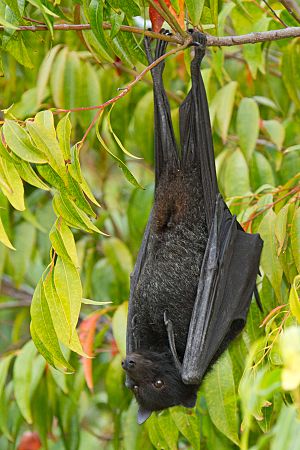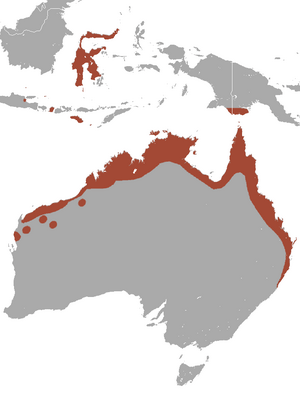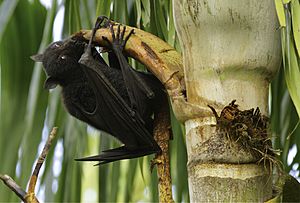Black flying fox facts for kids
Quick facts for kids Black flying fox |
|
|---|---|
 |
|
| Conservation status | |
| Scientific classification | |
| Genus: |
Pteropus
|
| Species: |
alecto
|
| Subspecies | |
|
|
 |
|
| Black flying fox range | |
The black flying fox (Pteropus alecto) is a type of bat. It is also known as the black fruit bat. These bats are among the biggest bats in the world. However, they are not the very largest species in their group.
Black flying foxes live in Australia, Papua New Guinea, and Indonesia. They are not considered an endangered species right now.
Contents
What Do They Look Like?
Black flying foxes have short, black fur. They have a reddish-brown patch of fur around their shoulders. Their forearm, which is part of their wing, is about 164 millimeters (6.46 inches) long.
These bats usually weigh around 710 grams (1.57 pounds). They are one of the largest bat species. Their wings can spread out to more than 1 meter (3 feet) wide!
Where Do They Live?
Black flying foxes are native to several places. They live in parts of Australia. This includes New South Wales, Queensland, Northern Territory, and Western Australia.
They also live in Western Province in Papua New Guinea. In Indonesia, you can find them in West Papua, Sulawesi, Sumba, and Savu.
Where Do They Sleep?
During the day, black flying foxes sleep in large groups. These groups are called roosts, colonies, or 'camps'. A single camp can have hundreds or even tens of thousands of bats!
Sometimes, they share their sleeping spots with other types of flying foxes. These include the grey-headed flying fox, the spectacled flying fox, and the little red flying fox. They like to roost in mangroves, swamps, rainforests, and bamboo forests. It is very rare for them to sleep in caves.
How Do They Have Babies?
Black flying foxes have babies once a year. The mother usually gives birth to one baby at a time. For the first month, the mother carries her baby with her.
After that first month, the baby stays in the roost. The mother then leaves the baby behind when she goes out to find food at night.
What Do They Eat?
Black flying foxes love to eat pollen and nectar. They get these from native trees like eucalyptus, lilypillies, paperbark, and turpentine trees.
If their usual food is hard to find, like during a drought, they might eat other fruits. They can eat fruits like mangos and apples. These bats can fly up to 50 kilometers (31 miles) in one night to find food!
In cities, they have learned to eat fruit from cocos palm trees. This fruit now makes up about 30% of their diet. However, these palm fruits are very acidic. Eating too many can make the bats sick and even cause them to die.
Protecting Black Flying Foxes
The black flying fox is not currently on the endangered list. However, they still face some challenges. Their homes and food sources are sometimes lost.
When these bats live near people, they can sometimes be seen as a problem. Because of their habits, they can get into trouble with humans. This can lead to bats being harmed in fruit orchards. Their roosting places can also be disturbed or destroyed. In Indonesia, these bats are sometimes hunted for food. People are worried this might not be good for their numbers.
Bats and Health
Scientists have found that black flying foxes can carry certain viruses. These viruses can sometimes be passed to humans. Examples include Australian bat lyssavirus, Hendra virus, and Menangle virus.
It is important to know that only the Australian bat lyssavirus is known to have spread from bats to humans. This has only happened in a very few, rare cases. It is always best not to touch wild bats.
Helping Injured Bats
Many wildlife rescue groups in Australia help flying foxes. Organizations like Wildcare Australia and WIRES often get calls about bats that are hurt, sick, or abandoned.
A common cause of injury for adult flying foxes is getting caught. They can get tangled in barbed wire fences. They also get caught in loose, poorly set up fruit tree netting. These injuries can be very serious. They can cause a lot of pain and even lead to death if the bat is not rescued quickly.
Images for kids
See also
 In Spanish: Zorro volador negro para niños
In Spanish: Zorro volador negro para niños






